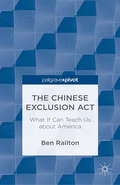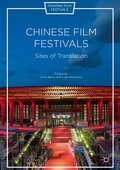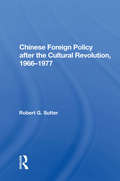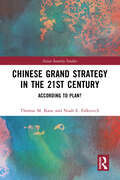- Table View
- List View
The Chinese Exclusion Act: What It Can Teach Us about America
by B. RailtonThis book explores two critical strands in American Studies: policy conversations on legal and illegal immigration and social and educational conversations on diversity and multiculturalism. As author Benjamin Railton shows, a fresh look at the Chinese Exclusion Act overturns much of the received wisdom on immigration and American identity.
The Chinese Face of Jesus Christ: Volume 2
by Roman MalekThis collection in five volumes tries to realize the desideratum of a comprehensive interdisciplinary work on the manifold faces and images of Jesus in China, which unites the Sinological, mission-historical, theological, art-historical, and other aspects. The first three volumes (vols. L/1-3) contain articles and texts which discuss the faces and images of Jesus Christ from the Tang dynasty to the present time. In a separate volume (vol. L/4) follows an annotated bibliography of the Western and Chinese writings on Jesus Christ in China and a general index with glossary. The iconography, i.e., the attempts of the Western missionaries and the Chinese to portray Jesus in an artistic way, will be presented in the fifth volume of this collection (vol. L/5).
The Chinese Face of Jesus Christ: Volume 2
by Roman MalekThis collection in five volumes tries to realize the desideratum of a comprehensive interdisciplinary work on the manifold faces and images of Jesus in China, which unites the Sinological, mission-historical, theological, art-historical, and other aspects. The first three volumes (vols. L/1-3) contain articles and texts which discuss the faces and images of Jesus Christ from the Tang dynasty to the present time. In a separate volume (vol. L/4) follows an annotated bibliography of the Western and Chinese writings on Jesus Christ in China and a general index with glossary. The iconography, i.e., the attempts of the Western missionaries and the Chinese to portray Jesus in an artistic way, will be presented in the fifth volume of this collection (vol. L/5).
The Chinese Face of Jesus Christ: Volume 1
by Roman MalekThe Chinese Face of Jesus Christ: Volume 1
The Chinese Face of Jesus Christ: Volume 3a
by Roman MalekThis collection in five volumes tries to realize the desideratum of a comprehensive interdisciplinary work on the manifold faces and images of Jesus in China, which unites the Sinological, mission-historical, theological, art-historical, and other aspects. The first three volumes (vols. L/1-3) contain articles and texts which discuss the faces and images of Jesus Christ from the Tang dynasty to the present time. In a separate volume (vol. L/4) follows an annotated bibliography of the Western and Chinese writings on Jesus Christ in China and a general index with glossary. The iconography, i.e., the attempts of the Western missionaries and the Chinese to portray Jesus in an artistic way, will be presented in the fifth volume of this collection (vol. L/5).
The Chinese Face of Jesus Christ: Volume 3a
by Roman MalekThis collection in five volumes tries to realize the desideratum of a comprehensive interdisciplinary work on the manifold faces and images of Jesus in China, which unites the Sinological, mission-historical, theological, art-historical, and other aspects. The first three volumes (vols. L/1-3) contain articles and texts which discuss the faces and images of Jesus Christ from the Tang dynasty to the present time. In a separate volume (vol. L/4) follows an annotated bibliography of the Western and Chinese writings on Jesus Christ in China and a general index with glossary. The iconography, i.e., the attempts of the Western missionaries and the Chinese to portray Jesus in an artistic way, will be presented in the fifth volume of this collection (vol. L/5).
The Chinese Face of Jesus Christ: Volume 3b
by Roman MalekThis collection in five volumes tries to realize the desideratum of a comprehensive interdisciplinary work on the manifold faces and images of Jesus in China, which unites the Sinological, mission-historical, theological, art-historical, and other aspects. The first three volumes (vols. L/1-3) contain articles and texts which discuss the faces and images of Jesus Christ from the Tang dynasty to the present time. In a separate volume (vol. L/4) follows an annotated bibliography of the Western and Chinese writings on Jesus Christ in China and a general index with glossary. The iconography, i.e., the attempts of the Western missionaries and the Chinese to portray Jesus in an artistic way, will be presented in the fifth volume of this collection (vol. L/5). "This unique ongoing project continues to open a new, vital lens to learn more about China in its intellectual and cultural dimensions." John Witek in Journal of Asian Studies
The Chinese Face of Jesus Christ: Volume 3b
by Roman MalekThis collection in five volumes tries to realize the desideratum of a comprehensive interdisciplinary work on the manifold faces and images of Jesus in China, which unites the Sinological, mission-historical, theological, art-historical, and other aspects. The first three volumes (vols. L/1-3) contain articles and texts which discuss the faces and images of Jesus Christ from the Tang dynasty to the present time. In a separate volume (vol. L/4) follows an annotated bibliography of the Western and Chinese writings on Jesus Christ in China and a general index with glossary. The iconography, i.e., the attempts of the Western missionaries and the Chinese to portray Jesus in an artistic way, will be presented in the fifth volume of this collection (vol. L/5). "This unique ongoing project continues to open a new, vital lens to learn more about China in its intellectual and cultural dimensions." John Witek in Journal of Asian Studies
Chinese Film Festivals: Sites of Translation (Framing Film Festivals)
by Chris Berry Luke RobinsonThis book is the first anthology of research devoted to the booming world of Chinese film festivals, covering both mainstream and independent films. It also explores festivals in the Chinese-speaking world and festivals of Chinese films in the rest of the world. The book asks how Chinese film festivals function as sites of translation, translating Chinese culture to the world and world culture to Chinese-speaking audiences, and also how the international film festival model is being transformed as it is translated into the Chinese-speaking world.
Chinese Films in Focus II
by Chris BerryChinese cinema continues to go from strength to strength. After art-house hits like Chen Kaige's Yellow Earth (1984) and Wong Kar-wai's In the Mood for Love (2000), the Oscar-winning success of Ang Lee's Crouching Tiger Hidden Dragon (2000) disproved the old myth that subtitled films could not succeed at the multiplex. Chinese Films in Focus II updates and expands the original Chinese Films in Focus: 25 New Takes with fourteen brand new essays, to offer thirty-four fresh and insightful readings of key individual films. The new edition addresses films from mainland China, Taiwan, Hong Kong and other parts of the Chinese diaspora and the historical coverage ranges from the 1930s to the present. The essays, by leading authorities on Chinese cinema as well as up-and-coming scholars, are concise, accessible, rich, and on the cutting edge of current research. Each contributor outlines existing writing and presents an original perspective on the film, making this volume a rich resource for classroom use, scholarly research and general reading for anyone wanting to understand more about the historical development and rich variety of Chinese cinema.Contributors: Annette Aw, Chris Berry, Yomi Braester, Felicia Chan, Esther Cheung, Robert Chi, Rey Chow, Mary Farquhar, Carolyn FitzGerald, Ping Fu, Kristine Harris, Margaret Hillenbrand, Brian Hu, Tan See Kam, Haiyan Lee, Vivian Lee, Helen Hok-Sze Leung, David Leiwei Li, Song Hwee Lim, Kam Louie, Fran Martin, Jason McGrath, Corrado Neri, Jonathan Noble, Beremoce Reynaud, Cui Shuqin, Julian Stringer, Janice Tong, Yiman Wang, Faye Hui Xiao, Gang Gary Xu, Audrey Yue, Yingjin Zhang, John ZouThe Editor: Chris Berry is Professor of Film and Television at Goldsmiths, University of London.
Chinese Films in Focus II
by Chris BerryChinese cinema continues to go from strength to strength. After art-house hits like Chen Kaige's Yellow Earth (1984) and Wong Kar-wai's In the Mood for Love (2000), the Oscar-winning success of Ang Lee's Crouching Tiger Hidden Dragon (2000) disproved the old myth that subtitled films could not succeed at the multiplex. Chinese Films in Focus II updates and expands the original Chinese Films in Focus: 25 New Takes with fourteen brand new essays, to offer thirty-four fresh and insightful readings of key individual films. The new edition addresses films from mainland China, Taiwan, Hong Kong and other parts of the Chinese diaspora and the historical coverage ranges from the 1930s to the present. The essays, by leading authorities on Chinese cinema as well as up-and-coming scholars, are concise, accessible, rich, and on the cutting edge of current research. Each contributor outlines existing writing and presents an original perspective on the film, making this volume a rich resource for classroom use, scholarly research and general reading for anyone wanting to understand more about the historical development and rich variety of Chinese cinema.Contributors: Annette Aw, Chris Berry, Yomi Braester, Felicia Chan, Esther Cheung, Robert Chi, Rey Chow, Mary Farquhar, Carolyn FitzGerald, Ping Fu, Kristine Harris, Margaret Hillenbrand, Brian Hu, Tan See Kam, Haiyan Lee, Vivian Lee, Helen Hok-Sze Leung, David Leiwei Li, Song Hwee Lim, Kam Louie, Fran Martin, Jason McGrath, Corrado Neri, Jonathan Noble, Beremoce Reynaud, Cui Shuqin, Julian Stringer, Janice Tong, Yiman Wang, Faye Hui Xiao, Gang Gary Xu, Audrey Yue, Yingjin Zhang, John ZouThe Editor: Chris Berry is Professor of Film and Television at Goldsmiths, University of London.
Chinese Foreign Policy: An Introduction
by Marc LanteigneThis updated and expanded 3rd edition of Chinese Foreign Policy seeks to explain the processes, actors and current history behind China’s international relations, as well as offering an in-depth look at the key areas of China’s modern global relations. Among the key issues are: The expansion of Chinese foreign policy from regional to international interests China’s growing economic power in an era of global financial uncertainty Modern security challenges, including maritime security, counter-terrorism and protection of overseas economic interests The shifting power relationship with the United States, as well as with the European Union, Russia and Japan. China’s engagement with a growing number of international and regional institutions and legal affairs The developing great power diplomacy of China New chapters address not only China’s evolving foreign policy interests but also recent changes in the international system and the effects of China’s domestic reforms. In response to current events, sections addressing Chinese trade, bilateral relations, and China’s developing strategic interest in Russia and the Polar Regions have be extensively revised and updated. This book will be essential reading for students of Chinese foreign policy and Asian international relations, and highly recommended for students of diplomacy, international security and IR in general.
Chinese Foreign Policy: An Introduction
by Marc LanteigneThis updated and expanded 3rd edition of Chinese Foreign Policy seeks to explain the processes, actors and current history behind China’s international relations, as well as offering an in-depth look at the key areas of China’s modern global relations. Among the key issues are: The expansion of Chinese foreign policy from regional to international interests China’s growing economic power in an era of global financial uncertainty Modern security challenges, including maritime security, counter-terrorism and protection of overseas economic interests The shifting power relationship with the United States, as well as with the European Union, Russia and Japan. China’s engagement with a growing number of international and regional institutions and legal affairs The developing great power diplomacy of China New chapters address not only China’s evolving foreign policy interests but also recent changes in the international system and the effects of China’s domestic reforms. In response to current events, sections addressing Chinese trade, bilateral relations, and China’s developing strategic interest in Russia and the Polar Regions have be extensively revised and updated. This book will be essential reading for students of Chinese foreign policy and Asian international relations, and highly recommended for students of diplomacy, international security and IR in general.
Chinese Foreign Policy: An Introduction
by Marc LanteigneThis updated and expanded fourth edition of Chinese Foreign Policy seeks to examine the decision-makers, processes and rationales behind China’s expanding international relations as well as offering an in-depth look at China’s modern global relations. Among the key issues explored in this edition are: The further expansion of Chinese foreign policy from regional (Asia-Pacific) to international interests; How the government of Xi Jinping has pursued a more confident great power foreign policy agenda; China’s growing economic power in an era of global financial uncertainty and the return of protectionism; Modern security challenges, including counter-terrorism, cyber-security, maritime power, military reform and modernisation, and the protection of overseas economic interests; China’s shifting power relationship with the United States under President Donald Trump; The deeper engagement of Beijing with a growing number of international and regional institutions and legal affairs; Cross-regional diplomacy, including updated sections on Africa, Latin America, the Middle East, and Russia/Eurasia, as well as Oceania and the Polar regions; The development of the Belt and Road Initiative as a centrepiece of China’s foreign policy. This book will be essential reading for students of Chinese Foreign Policy and Asian International Relations, and highly recommended for students of diplomacy, international security and IR in general.
Chinese Foreign Policy: An Introduction
by Marc LanteigneThis updated and expanded fourth edition of Chinese Foreign Policy seeks to examine the decision-makers, processes and rationales behind China’s expanding international relations as well as offering an in-depth look at China’s modern global relations. Among the key issues explored in this edition are: The further expansion of Chinese foreign policy from regional (Asia-Pacific) to international interests; How the government of Xi Jinping has pursued a more confident great power foreign policy agenda; China’s growing economic power in an era of global financial uncertainty and the return of protectionism; Modern security challenges, including counter-terrorism, cyber-security, maritime power, military reform and modernisation, and the protection of overseas economic interests; China’s shifting power relationship with the United States under President Donald Trump; The deeper engagement of Beijing with a growing number of international and regional institutions and legal affairs; Cross-regional diplomacy, including updated sections on Africa, Latin America, the Middle East, and Russia/Eurasia, as well as Oceania and the Polar regions; The development of the Belt and Road Initiative as a centrepiece of China’s foreign policy. This book will be essential reading for students of Chinese Foreign Policy and Asian International Relations, and highly recommended for students of diplomacy, international security and IR in general.
Chinese Foreign Policy/h
by Robert G. SutterChinese foreign policy has changed radically since the Cultural Revolution of 1966-1969. This book focuses on turning points in China's policy and looks at the influence of foreign pressures on China. It assesses the impact of internal political struggles on the conduct of Chinese foreign affairs.
Chinese Foreign Policy/h
by Robert G. SutterChinese foreign policy has changed radically since the Cultural Revolution of 1966-1969. This book focuses on turning points in China's policy and looks at the influence of foreign pressures on China. It assesses the impact of internal political struggles on the conduct of Chinese foreign affairs.
Chinese Foreign Relations with Weak Peripheral States: Asymmetrical Economic Power and Insecurity (Asian Security Studies)
by Jeffrey ReevesThis book examines China’s relations with its weak peripheral states through the theoretical lens of structural power and structural violence. China’s foreign policy concepts toward its weak neighbouring states, such as the ‘One Belt, One Road’ strategy, are premised on the assumption that economic exchange and a commitment to common development are the most effective means of ensuring stability on its borders. This book, however, argues that China’s overreliance on economic exchange as the basis for its bilateral relations contains inherently self-defeating qualities that have contributed and can further contribute to instability and insecurity within China’s periphery. Unequal economic exchange between China and its weak neighbours results in Chinese influence over the state’s domestic institutions, what this book refers to as ‘structural power’. Chinese structural power, in turn, can undermine the state’s development, contribute to social unrest, and exacerbate existing state/society tensions—what this book refers to as ‘structural violence’. For China, such outcomes lead to instability within its peripheral environment and raise its vulnerability to security threats stemming from nationalism, separatism, terrorism, transnational organised crime, and drug trafficking, among others. This book explores the causality between China’s economically-reliant foreign policy and insecurity in its weak peripheral states and considers the implications for China’s security environment and foreign policy. This book will be of much interest to students of Chinese politics, Asian security studies, international political economy and IR in general.
Chinese Foreign Relations with Weak Peripheral States: Asymmetrical Economic Power and Insecurity (Asian Security Studies)
by Jeffrey ReevesThis book examines China’s relations with its weak peripheral states through the theoretical lens of structural power and structural violence. China’s foreign policy concepts toward its weak neighbouring states, such as the ‘One Belt, One Road’ strategy, are premised on the assumption that economic exchange and a commitment to common development are the most effective means of ensuring stability on its borders. This book, however, argues that China’s overreliance on economic exchange as the basis for its bilateral relations contains inherently self-defeating qualities that have contributed and can further contribute to instability and insecurity within China’s periphery. Unequal economic exchange between China and its weak neighbours results in Chinese influence over the state’s domestic institutions, what this book refers to as ‘structural power’. Chinese structural power, in turn, can undermine the state’s development, contribute to social unrest, and exacerbate existing state/society tensions—what this book refers to as ‘structural violence’. For China, such outcomes lead to instability within its peripheral environment and raise its vulnerability to security threats stemming from nationalism, separatism, terrorism, transnational organised crime, and drug trafficking, among others. This book explores the causality between China’s economically-reliant foreign policy and insecurity in its weak peripheral states and considers the implications for China’s security environment and foreign policy. This book will be of much interest to students of Chinese politics, Asian security studies, international political economy and IR in general.
The Chinese Gold Murders (Penguin Modern Classics – Crime & Espionage)
by Robert Van GulikJudge Dee is about to step into the shoes of a dead man…Most people would refuse the job of Magistrate at the lonely port town of Peng-lai – especially as the last occupant of the post has been found poisoned in his library, his papers missing. But Judge Dee is not most men. He arrives ready to get to the truth, only to find his life complicated even further by a missing bride, a vanished artisan, a man-eating tiger and an evil conspiracy.
Chinese Government Leaders in Manchukuo, 1931-1937: Intertwined National Ideals (Routledge Studies in the Modern History of Japan)
by Jianda YuanDrawing on historiography of the Japanese occupation in the Chinese, Japanese, and English languages, this book examines the politics of the Manchukuo puppet state from the angle of notable Chinese who cooperated with the Japanese military and headed its government institutions. The war in Asia between 1931 and 1945, and particularly the early years of the conflict from 1931 to 1937, is a topic of world history that is often glossed over or misinterpreted. Much of the research and public opinion on this period in China, Japan, and the West deem these Chinese figures to be traitors, particles of Japanese colonialism, and collaborators under occupation. In contrast, this book highlights the importance of analyzing the national ideas of Manchukuo’s Chinese government leaders as a method of understanding Manchukuo’s operating mechanisms, Sino-Japanese interactions, and China’s turbulent history in the early twentieth century. Chinese Government Leaders in Manchukuo, 1931-1937 fills a gap in this research and is an ideal resource for scholars studying wartime Asia and Europe, as well as non-specialist readers who are interested in collaboration in general.
Chinese Government Leaders in Manchukuo, 1931-1937: Intertwined National Ideals (Routledge Studies in the Modern History of Japan)
by Jianda YuanDrawing on historiography of the Japanese occupation in the Chinese, Japanese, and English languages, this book examines the politics of the Manchukuo puppet state from the angle of notable Chinese who cooperated with the Japanese military and headed its government institutions. The war in Asia between 1931 and 1945, and particularly the early years of the conflict from 1931 to 1937, is a topic of world history that is often glossed over or misinterpreted. Much of the research and public opinion on this period in China, Japan, and the West deem these Chinese figures to be traitors, particles of Japanese colonialism, and collaborators under occupation. In contrast, this book highlights the importance of analyzing the national ideas of Manchukuo’s Chinese government leaders as a method of understanding Manchukuo’s operating mechanisms, Sino-Japanese interactions, and China’s turbulent history in the early twentieth century. Chinese Government Leaders in Manchukuo, 1931-1937 fills a gap in this research and is an ideal resource for scholars studying wartime Asia and Europe, as well as non-specialist readers who are interested in collaboration in general.
Chinese Grand Strategy and Maritime Power (Cass Series: Naval Policy and History)
by Thomas M. KaneThis challenging new book argues that the People's Republic of China is pursuing a long-term strategy to extend its national power by sea.
Chinese Grand Strategy and Maritime Power: Enduring Ideas From The Chinese Strategic Tradition (Cass Series: Naval Policy and History)
by Thomas M. KaneThis challenging new book argues that the People's Republic of China is pursuing a long-term strategy to extend its national power by sea.
Chinese Grand Strategy in the 21st Century: According to Plan? (Asian Security Studies)
by Thomas M. Kane Noah FalkovichThis book examines the state of China’s grand strategy in the 21st century, including political, military and economic factors. Over the past two decades, the People’s Republic of China (PRC) has attained the second highest gross domestic product in the world, taken a leadership role in East Asian regional organisations and substantially improved its military capabilities. Each of these developments – and many others like them – have attracted attention from scholars, journalists and policymakers. Less frequently acknowledged – but perhaps of greater significance – is the impressive congruence of Beijing’s accomplishments. This book highlights how the PRC’s successes support one another and pave the way for future accomplishments, and how these successes seem to be achieved in an unusually coherent and purposeful way. As Beijing’s relations with the rest of the world continue to evolve, with events ranging from the ongoing global economic crisis to the turbulence in China’s own stock market which may bring the PRC’s government under pressure to re-order its priorities, this book assesses China’s grand strategy and long-term approach to national policy. It identifies the political, military and economic instruments it is likely to use, the key challenges which it will face, and explores the implications for the global community. This book will be of great interest to students of Chinese politics, foreign policy, strategic studies, international security and IR in general.















